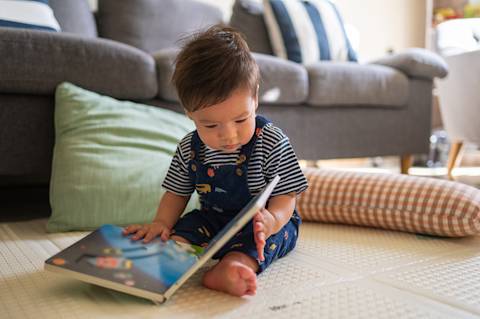Imagine this scenario: A child is playing with their sibling. All of a sudden, the sibling snatches a toy out of the child’s hands. Angry and upset, the child throws a block at their sibling. The block hits a picture frame, and the glass shatters. The caregiver runs into the room and starts yelling at the child, “No, don’t throw blocks! You’re on time out.” The child, still upset that their sibling took their toy, is now flooded with even more emotions because of their caregiver’s unexpected and big reaction. Instead of learning what they did wrong, the child throws a tantrum out of frustration, fear, anger, and all the emotions that they can’t yet put into words.

Some version of this scenario has happened in nearly every household with children at one point or another. As caregivers, it’s incredibly difficult to avoid a heated response when an outburst happens. However, through consistent communication about boundaries, expectations, and rules, caregivers can help prevent this scenario from happening.
Research shows that children thrive on routine and structure. Having consistent routines, rules, expectations, and boundaries helps them feel safe, secure, and in control. When children know what to expect and understand what's expected of them, they are more likely to feel confident and capable. We’ve provided some language you can use to help explain your expectations to your child and maintain consistency without disrupting your busy schedule.
Discuss your rules, boundaries, and expectations every day, or as often as possible
Younger children need lots of reminders about how you expect them to behave in different situations. Their brains are rapidly developing and growing, and they’re taking in a lot of new information every single day.
Keep your expectations specific
Children often don’t know what their caregiver means when they say “be good” or “be safe,” or they have a different idea of what it means than an adult might. As much as possible, provide them with specific expectations. For example:
“I expect you to listen to me and follow my directions.”
“I expect you to put your toys in the toybox when you’re done playing.”
“When you’re at the swimming pool, I expect you to walk instead of run.”
Provide simple, child-friendly reasons for why you’re setting these expectations
As children get older, they love to ask “why.” Explaining the reason behind your expectations can help them better understand why you’re setting the expectations, which can make it easier for them to follow those rules. For example:
"We always wash our hands before we eat. That's an important rule to keep us healthy."
"We use our inside voices when we're in the house. That way we don't disturb our neighbors."
"Going to bed is important, so you can get enough sleep and you can feel your best tomorrow."
Do your best to focus on what your child can do, rather than what they can’t do
Sometimes, we just have to tell our children “no.” But when we’re proactively communicating about boundaries and expectations, using positive language can help them feel more receptive to what you’re saying. This can help them feel more in control of their life. For example:
"Use gentle hands when playing with the puppy."
"Let's use our indoor voices."
"Let's look at this instead."
"Let’s use polite words."
"Let's take turns speaking."
"Let's be brave and face our fears together."
Be clear on the consequences if your expectations aren’t met
Consequences are an important part of setting expectations and boundaries with your child. Ideally, we want to set consequences that are connected to the expectation they didn’t meet. For example:
"If you can’t share your toy when you play with your friend, then I’ll have to take the toy away.”
"If you can’t use your gentle hands with the puppy, I’ll have to take the puppy away until you can be gentle.”
"If you run at the pool, we’ll have to leave.”
"If you don’t eat your dinner, then we can’t have treats after dinner.”
When you combine all of these steps, setting expectations and boundaries with your child can sound like:
"When the timer beeps, let's take a break from playing on the phone and do something else together because I love playing with you, and it keeps you healthy to move your body. I’ll put the phone away until tomorrow."
"Let's walk when we’re inside, so we can stay safe and avoid accidents. If you run while we’re inside, you will need to sit in your room quietly for a few minutes so you stay safe."
"It’s important to have an adult with you when you go outside so someone can make sure you’re staying safe. If you go outside by yourself, then I’ll take you to your room."
"It’s not OK to hit your sibling because hitting hurts. We love our brother/sister and want them to be safe. When you feel angry, you can take a deep breath and ask for help from an adult. If you hit your sibling again, then you can’t play with them until you can be gentle."
"If you don't wear your coat outside, you might feel cold and uncomfortable. It's important to dress appropriately for the weather so you can stay warm and healthy. If you don’t wear a coat, we won’t go to the park."
Importantly, these are guidelines and language that can be helpful when helping children understand what you expect of them. Every family is different, so adapt the language for what works best for you. The biggest takeaway is to stay as consistent as possible so your child knows what’s expected of them and what will happen if they don’t meet those expectations.

Psychology Today - En inglés
Parenting Exchange - En inglés
IRIS Center Peabody College Vanderbilt University - En inglés





